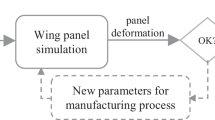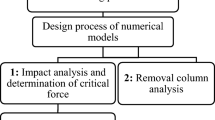The key results of fuel-assembly drop analysis in the event of the breakage of clamping or sling elements and an assessment of the aftereffects in transport-technological operations are presented. The computational analysis was performed using the LS-DYNA dynamic calculation module of the ANSYS software package. Full-scale 3D mathematical modeling allowed a detailed analysis of dynamic processes, cutting the design time, and lowering the cost of the structure being developed. The results obtained made it possible to analyze the impingement process, determine the plastic deformations arising in the elements of fuel assemblies, and make recommendations for strengthening the structure.
Similar content being viewed by others
References
G. Johnson and W. Cook, “A constitutive model and data for metals subjected to large strains, high strain rates, and high temperatures,” Proc. 7th Int. Symp. on Ballistic, The Netherlands (1983), pp. 541–547.
G. Taylor and A. Quinney, “The latent energy remaining in a metal after cold working,” Proc. Roy. Soc., 307–326 (1934).
A. Nadai, Plasticity and Destruction of Solids, Izd. Inostr. Lit., Moscow (1954).
PNAE G-7-002-86, Calculation Norms for the Strength of Equipment and Pipelines of Nuclear Power Plants, Energoatomizdat, Moscow (1989).
Handbook of the Properties of Materials for Advanced Reactor Technologies, Vol. 5, Properties of Reactor Steels and Alloys, IzdAT, Moscow (2014).
Temporary Guidance Materials on the Use of Data on the Properties of Structural Materials and SNUP Fuel to Justify the Performance of Experimental Fuel Elements ETWS of the BN-600 Reactor, State Corporation Rosatom, Moscow (2014), 2nd ed.
D. A. Lapshin, Calculation-Experimental Analysis of the Strength of Intra-Object Transport Containers of BN Type Reactors in Drop Accidents: Cand. Dissert. in Techn. Sci., NNGU im. Lobachevskogo, Nizhny Novgorod (2015).
V. E. Desyatnikov, A. Yu. Sidorov, A. V. Ryabtsov, and D. A. Lapshin, “Calculation and experimental substantiation of the strength characteristics of core assemblies under the influence of longitudinal shock loads,” At. Energ., 5, No. 2, 54–57 (2017).
Author information
Authors and Affiliations
Corresponding author
Additional information
Translated from Atomnaya Énergiya, Vol. 131, No. 5, pp. 295–298, November, 2021.
Rights and permissions
Springer Nature or its licensor holds exclusive rights to this article under a publishing agreement with the author(s) or other rightsholder(s); author self-archiving of the accepted manuscript version of this article is solely governed by the terms of such publishing agreement and applicable law.
About this article
Cite this article
Vilenskii, O.Y., Lapshin, D.A., Novinskii, E.G. et al. Computational Analysis and Evaluation of the Aftereffects of Fuel Assembly Drops Using Verified Deformation Models of Structural Materials. At Energy 131, 303–306 (2022). https://doi.org/10.1007/s10512-022-00883-3
Received:
Published:
Issue Date:
DOI: https://doi.org/10.1007/s10512-022-00883-3




